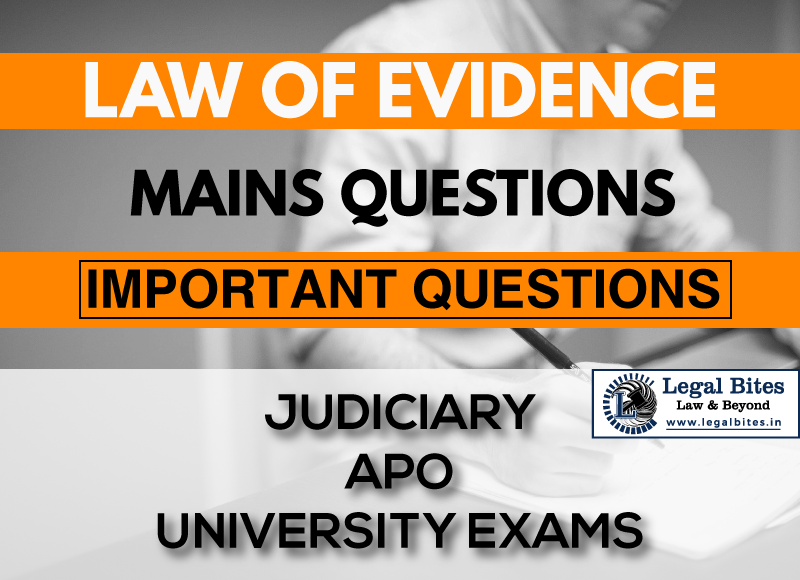An accused in a case of dacoity is produced before you by the investigating officer in a muffled face with a request for holding a test identification parade to fix his identity as a culprit. How will you deal with the application?
Question: An accused in a case of dacoity is produced before you by the investigating officer in a muffled face with a request for holding a test identification parade to fix his identity as a culprit. How will you deal with the application? [D.J.S. 2005] Find the answer to the mains question only on Legal Bites. [An accused… Read More »
;
Question: An accused in a case of dacoity is produced before you by the investigating officer in a muffled face with a request for holding a test identification parade to fix his identity as a culprit. How will you deal with the application? [D.J.S. 2005] Find the answer to the mains question only on Legal Bites. [An accused in a case of dacoity is produced before you by the investigating officer in a muffled face with a request for holding a test identification parade to fix his identity as...
Question: An accused in a case of dacoity is produced before you by the investigating officer in a muffled face with a request for holding a test identification parade to fix his identity as a culprit. How will you deal with the application? [D.J.S. 2005]
Find the answer to the mains question only on Legal Bites. [An accused in a case of dacoity is produced before you by the investigating officer in a muffled face with a request for holding a test identification parade to fix his identity as a culprit. How will you deal with the application?]
Answer
The utility of the evidence created by an identification parade was explained by the Supreme Court in Ramanathan v. State of Tamil Nadu, [AIR 1978 SC 1201].
Singhal J. said-
Identification parades have been in common use for a very long time for the object of placing the suspect in a line-up with other persons for identification. The purpose is to find out whether he is the perpetrator of the crime. This is all the more necessary where the name of the offender is not mentioned by those who claim to be eye-witnesses of the incident, but they claim that although they did not know him earlier, they could recall his features insufficient details and would also be able to identify him if and when they happen to see him again. Such identification is in the interest of both, the accused and the investigating agency.
It enables the investigating officer to ascertain whether the witnesses had really seen the perpetrator of the crime and test their capacity to identify him and thereby filling the gap in the investigation regarding the identity of the culprit. The line-up of the accused in a test identification parade is therefore a workable way of testing the memory and veracity of the witnesses and has worked well in actual practice.
However, as Venkatachaliah J. relied upon authorities as to the value of and disservice by, identification evidence said: The one area of criminal evidence susceptible of a miscarriage of criminal justice is the error in the identification of the criminal.
It is essential to rely on the decision given by the Apex Court in the recent case of Md. Sajjad v. State of West Bengal, AIR 2017 SC 642, that parade test though allowed and with the scope of taking the result as relevant, is not made the sole basis for the conviction of the accused.
In the instant case also, the court noted for the cases where the conviction is based not solely on the basis of identification in court, but on the basis of other corroborative evidence, such as the recovery of looted articles, stand on a different footing and the court has to consider the evidence in its entirety. It is also necessary to see that the accused was brought for a parade test without causing much delay after the date of occurrence of crime.
Therefore, in the present case at hand, when an accused in a case of dacoity is produced before by the investigating officer before the court in a muffled face with a request for holding a test identification parade to fix his identity as a culprit, it is crucial to first judge the veracity of the statement of witnesses and even if the test is allowed to be conducted, it shall not form the sole basis for the conviction of the accused. It is to be remembered that in the interest of justice TIP only acts as supporting evidence and not as a substantive piece of evidence to decide the guilt of the accused.
Important Mains Questions Series for Judiciary, APO & University Exams
- Law of Evidence Mains Questions Series Part-I
- Law of Evidence Mains Questions Series Part-II
- Law of Evidence Mains Questions Series Part-III
- Law of Evidence Mains Questions Series Part-IV
- Law of Evidence Mains Questions Series Part-V
- Law of Evidence Mains Questions Series Part-VI
- Law of Evidence Mains Questions Series Part-VII
- Law of Evidence Mains Questions Series Part-VIII
- Law of Evidence Mains Questions Series Part-IX
- Law of Evidence Mains Questions Series Part-X

